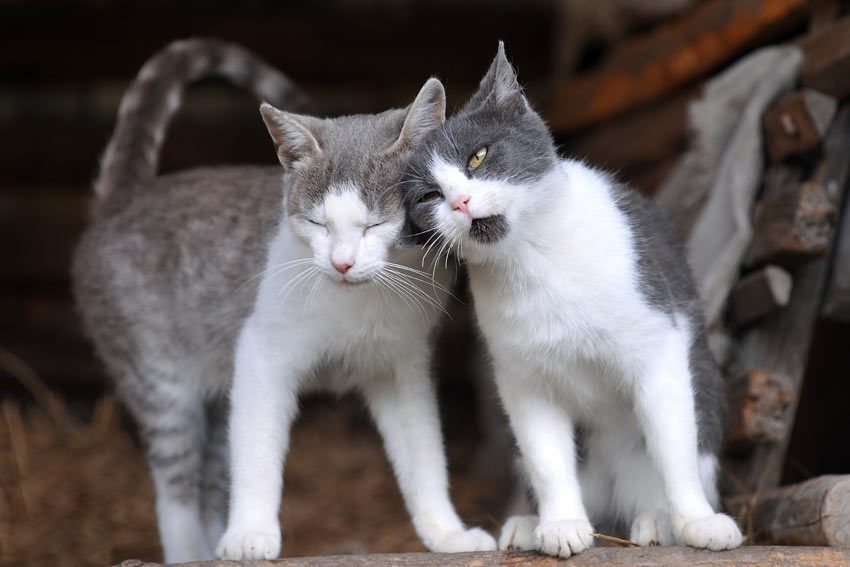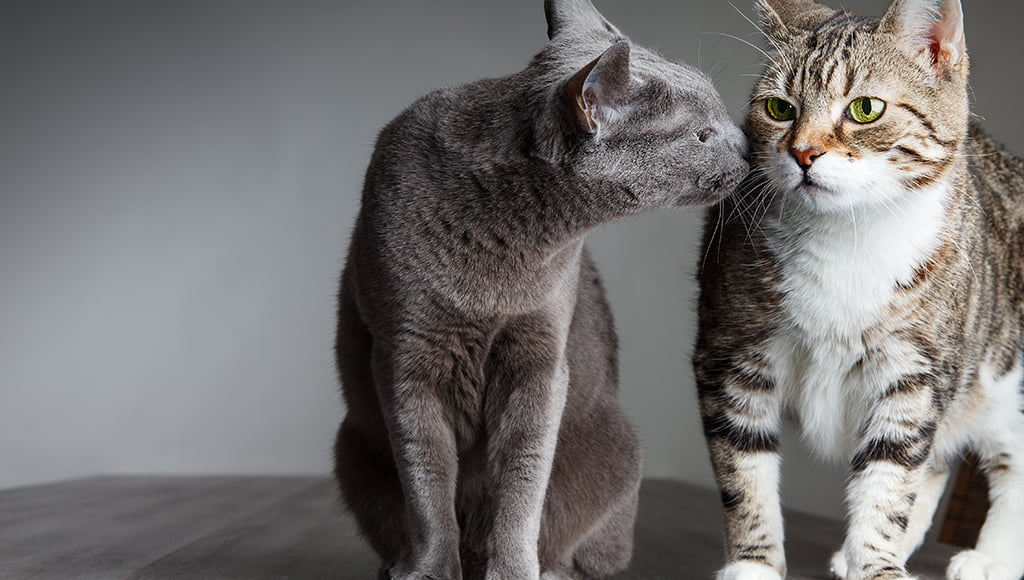How to Get Two Cats to Like Each Other (7 Simple Steps)

For pet owners who have multiple cats, we all know how hard it is to get two cats to like each other. Cats seem to have their own rules however despite that there is an easy way to ensure harmony between multiple cats in a household.
This guide is here to walk you through the steps in a straightforward way. We’ll chat about letting them ease into each other’s company without any drama and how to encourage a friendly vibe. Cats have their quirks, so we’ll keep it simple and relaxed. From letting them check out each other’s scents to creating a positive environment with treats and play, we’ll cover the bases.
It’s all about making sure each cat has its own space and taking it easy if things get a bit tricky. Let’s make the process of getting your two cats to like each other as smooth as possible.
How long does it take for cats to get used to each other?
The timeframe for cats to get used to each other hinges on various factors such as their unique personalities, past experiences, and the introduction process. Some cats may establish a comfortable rapport within a few days, while others might require more extended periods, stretching from weeks to months. Therefore, there is no fixed timeframe for two cats to get along.
The key ingredient in this process is patience. By initiating gradual introductions, allowing for scent exchanges, and maintaining a watchful eye on their body language, a positive foundation can be established.
Positive interactions, such as shared playtime and treats, contribute to expediting the bonding process. However, it’s crucial to respect each cat’s pace, intervening only if signs of distress persist. The timeline ultimately revolves around the distinct dynamics of the involved cats, emphasizing the importance of a patient and adaptable approach to cultivate a harmonious relationship.
How to Get Two Cats to Like Each Other

Before we begin on a step-by-step process to get two cats to like each other, it’s important to understand cats and their behavior:
Understanding Cats Behavior
Cats are creatures of habit, and unlocking the secrets of their behavior is fundamental to creating a harmonious environment for multiple feline friends. Cats communicate primarily through body language, vocalizations, and scent. Recognizing their non-verbal cues, such as tail positions, ear movements, and purring, provides valuable insights into their emotions and intentions.
Understanding a cat’s need for territory is crucial when introducing new companions. Cats establish and defend territories to feel safe and secure. Respect for individual spaces, including separate feeding and resting areas, fosters a sense of ownership and reduces potential conflicts.
Moreover, cats thrive on routine. Abrupt changes in their environment or daily schedule can induce stress. Gradual introductions and maintaining a consistent routine contribute to a smoother adjustment process.
Step 1: Scent Exchange
In the first step of introducing your cats, engage in a scent exchange. This involves swapping bedding or toys between the feline companions. By intertwining their scents, you create a bridge of familiarity, allowing each cat to gradually recognize the unique essence of their counterpart.
This simple yet effective process lays the foundation for a positive association, paving the way for a smoother introduction. Scent exchange taps into the cat’s keen sense of smell, a vital aspect of their communication, and sets the stage for the subsequent steps in fostering a harmonious relationship between your furry friends.
Step 2: Separate Spaces
In the second step, establish separate spaces for each cat, each equipped with essentials like food, water, and a snug bed. This intentional separation is pivotal, offering individual felines a designated haven where they can acclimate at their own rhythm.
Providing this controlled environment minimizes stress, allowing each cat to explore and adapt comfortably. The approach respects their need for personal territory, ensuring a gradual and measured introduction that sets the stage for a more harmonious coexistence between the two cats in the shared living space.
Step 3: Visual Introductions
For the third step, initiate visual introductions by partially opening a door or using a baby gate. This controlled exposure allows the cats to observe each other without direct contact, minimizing potential stress or fear.
The gradual nature of this introduction method provides a sense of safety, enabling the felines to become accustomed to the visual presence of their new companion. By carefully orchestrating these initial visual encounters, you pave the way for a smoother transition, fostering curiosity and acceptance between the cats as they embark on the journey of getting to know each other.
Step 4: Positive Reinforcement
In the fourth step, implement positive reinforcement to cultivate a friendly atmosphere. Reward calm behavior with treats and affection, creating positive associations between the cats. This simple yet powerful technique not only strengthens their positive connections but also serves to alleviate any potential anxiety during their interactions.
By consistently acknowledging and rewarding desirable behavior, you foster a conducive environment for the cats to associate each other with positive experiences, contributing to a more harmonious relationship as they navigate the journey of becoming familiar companions.
Step 5: Shared Experiences
In the fifth step, facilitate shared experiences by involving both cats in activities like playtime and simultaneous feeding. These positive shared moments play a crucial role in building a bond between the feline companions. Engaging in mutually enjoyable activities fosters a sense of camaraderie, encouraging the cats to associate each other with pleasant interactions.
Through these shared experiences, you not only promote a positive connection but also create lasting impressions that contribute to the development of a strong and amicable relationship between your two cats.
Step 6: Respect Individual Spaces
In the sixth step, prioritize respecting individual spaces by providing each cat with designated areas for necessities such as food, water, and litter boxes. This deliberate separation helps minimize territorial conflicts, ensuring each feline has a sense of ownership over its personal space.
By acknowledging and accommodating their need for autonomy, you create an environment that fosters a peaceful coexistence, laying the groundwork for a harmonious relationship between the two cats as they navigate their shared living space.
Step 7: Provide Vertical Spaces
In the seventh step, enhance your living space by incorporating vertical spaces, such as cat trees or shelves. Offering elevated territories caters to feline instincts, providing a sense of security and reducing the likelihood of conflicts.
These vertical elements allow each cat to claim their own perch, promoting harmony by minimizing territorial disputes. As they explore and establish their individual elevated spots, you contribute to the creation of a peaceful and accommodating environment, fostering a positive atmosphere for both cats to coexist comfortably in their shared living space.
Alternate Methods: Exploring Additional Approaches
If, despite your patience and efforts to follow the aforementioned steps, your cats aren’t quite hitting it off, there are alternative methods worth exploring to encourage a more positive relationship:
Professional Guidance
Consider seeking advice from a veterinarian or a professional animal behaviorist. Their expertise can provide valuable insights into the specific dynamics of your cats and offer personalized solutions tailored to their unique needs.
Slow and Steady Wins the Race
If initial attempts haven’t yielded positive results, consider slowing down the introduction process. Give your cats more time to adjust by extending the duration of each step. Patience is key, and a gradual approach may be the missing ingredient for their budding friendship.
Separate But Equal
If your cats still struggle to get along, you might explore the option of maintaining separate living quarters for each feline. This approach involves providing individual resources such as food, water, and litter boxes to minimize competition and reduce stress.
Enrichment Activities
Engage your cats in enrichment activities to stimulate their minds and divert their attention from potential conflicts. Puzzle feeders, interactive toys, and designated playtime can redirect their focus and create positive shared experiences.
Consider Feliway Products
Feliway products, such as diffusers or sprays, release synthetic feline facial pheromones that promote a calm environment. These can be particularly useful in reducing stress and tension between your cats, creating a more relaxed atmosphere.
Conclusion
Building a positive relationship between two cats is a gradual process that requires time, patience, and a keen understanding of feline behavior. By respecting their individual needs, providing positive experiences, and monitoring their interactions, you can increase the likelihood of your cats forming a strong and harmonious bond. Remember, each cat is unique, and a thoughtful approach tailored to their personalities will contribute to a successful introduction and a lasting friendship.


